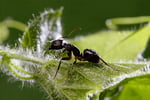
European Crane Fly The European crane fly, tipula paludosa, is a species not native to the United States. It is an introduced species that feeds on grass roots and can be a pest in turf. Other crane fly species are native to the U.S., and these insects are not considered threats to lawns. In fact, they serve a beneficial role by speeding the decomposition of organic matter. The crane fly life cycle spans approximately one year with the following life stages: egg – larva – pupa – adult. The larval stage is the longest in the life cycle and lasts approximately 10 months. European crane fly larvae often are called leatherjackets because of their thick, greyish colored skin.
They hatch and cause damage to grass by feeding on grass roots and stems through the winter and into the following spring. Cold winters with little snow cover can result in heavy larvae mortality.
 Besides the damage done to lawns by crane fly larvae, birds, such as ravens, may feed on the larvae, and through digging and pecking, the birds also may cause significant damage to lawns. In May-June, leatherjackets stop feeding, make a cocoon and become pupae. In July-August, the pupae emerge as adults, and within 24 hours the adults swarm, breed and die after laying between 200 to 500 eggs in grass.
Besides the damage done to lawns by crane fly larvae, birds, such as ravens, may feed on the larvae, and through digging and pecking, the birds also may cause significant damage to lawns. In May-June, leatherjackets stop feeding, make a cocoon and become pupae. In July-August, the pupae emerge as adults, and within 24 hours the adults swarm, breed and die after laying between 200 to 500 eggs in grass.
Treatment for these pest are done in the fall and through the spring. They can cause severe damage to your lawn. Contact Washington Tree & Lawn care to get a complete assessment of your lawn to see if you need crane fly control.
Reference: http://www.fws.gov/alaska/fisheries/contaminants/pdf/cranefly300.PDF










